Epcot AtMousePhere: The Music of World Showcase (Part 1)
I am betting that when I say “Epcot music,” there is a 95% chance you will think of something from Future World. The first music that actually comes to my mind is “Horizons.”
Now why is that? How come the music we relate to this huge theme park is usually only remembered from one half?
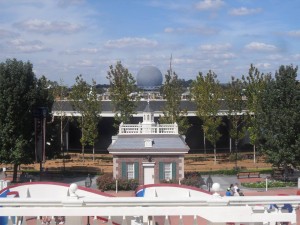 My guess is that, while most of the music in Future World is original music and can be attributed to the park, the music of World Showcase is mostly taken directly from those countries. You’ll hear Chinese music in China. You’ll hear British music in the United Kingdom. You’ll hear Italian music in Italy.
My guess is that, while most of the music in Future World is original music and can be attributed to the park, the music of World Showcase is mostly taken directly from those countries. You’ll hear Chinese music in China. You’ll hear British music in the United Kingdom. You’ll hear Italian music in Italy.
These pieces that are heard are probably some of the most popular pieces composed for those areas, but they aren’t meant to be associated with a theme park. They’re meant to be listened to while on a relaxing walk, or while sipping expensive coffee in a street cafe, or while sitting in a cushy chair in an orchestra hall.
But in Epcot, do you sometimes imagine yourself on a relaxing walk, or sitting in a street cafe, or sitting in a cushy chair in an orchestra hall? Well, then Epcot’s AtMousePhere has done it’s job. (The music, not the article series.)
Let’s see what we’ll hear as we journey around the lagoon. Since we finished our last article in the eastern part of the park, we’ll be starting our tour in Mexico and work our way clockwise.
Thanks to ParkTunes.com and the Shazam app for their assistance with this article.
Mexico
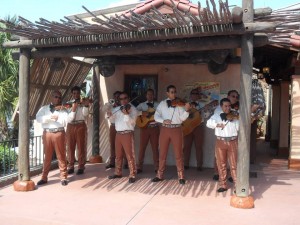 One of the reasons many people don’t listen to the audio of the Mexico pavilion (and don’t have any loops on YouTube) is likely because of the tour de force that is Mariachi Cobre. These fabulous musicians are under their shaded area outside of the Mexico pavilion many times during the day. With the addition of the Mexican Marimba Trio on Mariachi Cobre’s off days, there is a greater chance you’ll hear lovely live music as you pass the pavilion.
One of the reasons many people don’t listen to the audio of the Mexico pavilion (and don’t have any loops on YouTube) is likely because of the tour de force that is Mariachi Cobre. These fabulous musicians are under their shaded area outside of the Mexico pavilion many times during the day. With the addition of the Mexican Marimba Trio on Mariachi Cobre’s off days, there is a greater chance you’ll hear lovely live music as you pass the pavilion.
However, Mexico still offers some great audio very similar to the styles you’ll hear live outside the pavilion. You’ll get some very lovely mariachi and marimba music that sets the mood.
Norway
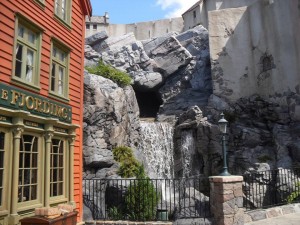 This area music is bound to change thanks to the Frozen takeover. But in the meantime, Norway offers a nice variety of styles as you wander around its area. From folksy tunes to full orchestral pieces, Norway provides a lot of great music.
This area music is bound to change thanks to the Frozen takeover. But in the meantime, Norway offers a nice variety of styles as you wander around its area. From folksy tunes to full orchestral pieces, Norway provides a lot of great music.
Some of the music you can hear includes “Sorensens vals, etter Olaf Sorli” by Drengestumusikken, the “Springdans,” which is a folk dance, and “Bruremersj I – Form Etter Ola Molokken” by Lom Spelemannslag.
Here is a sampling of some Norwegian area music, courtesy of YouTube user Disney Dreaming:
China’s music is lovely, and its unique instruments create a unique sound. The bamboo flute, erhu, and the many variations of the zithers and lutes means that if you closed your eyes and passed through the China area, you would know exactly where you were.
Probably the most popular song heard in the China loop is “Plucking Tea Leaves Song,” which I found on iTunes under its Chinese name. The English title on the CD is Evergreen Jade Classical Collection. Another song found on that CD is called “Big Harvest Celebration.” (Mind you, these are probably straight translations and aren’t the exact name of the song.) Another popular song is “A Joyful Reunion” by Feng Zichun.
You say “Germany,” and you think “German folk music.” This area doesn’t disappoint with oompah tunes and polka songs like the “Chromatic Polka” by Louis Koehler and “Bier Her.” It also has its fair share of yodeling music, like “Hi Lee, Hi Lo.”
If you get into the area at the top of the hour, be sure to get over to the clocktower, where a glockenspiel will play a merry little tune and figurines will come out.
Ready for some high-spirited music? In your tiring trek around the lagoon, the Italian music (and perhaps some gelato) will lift your feet. You’ll hear songs like “Funiculi Funicula” by Mario Lanza and “A Di La,” composed by Carlo Donida.
The “Chitarra Romana” is a dance that may get the romantics around us tapping their feet and maybe even picking up a partner! And if you’re really in the mood, you might even break into some opera with Pavarotti, like “O sole mio” by Eduardo di Capua or “Marechiare” by Paolo Tosti.
The American Adventure
This area where things get a little muddy. You see, there are a few pieces heard here that may sound very similar to music heard in the Liberty Square area of Magic Kingdom park, like “Battle Cry of Freedom” and “Hail Columbia.” It’s only natural to have these two areas (in two separate theme parks, remember) contain very similar music.
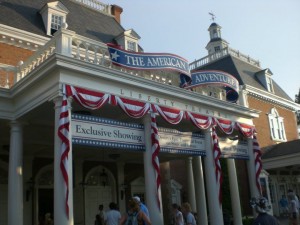 But while the Liberty Square music reflected the Revolutionary (and Civil) War periods, there are more songs in the American Adventure that cover other times in America’s history. For example, you’ll find “My Old Kentucky Home,” “Old Man River,” and “Home on the Range” heard here. The sound of these songs is much more subdued than the bold brass marches of its Magic Kingdom counterpart.
But while the Liberty Square music reflected the Revolutionary (and Civil) War periods, there are more songs in the American Adventure that cover other times in America’s history. For example, you’ll find “My Old Kentucky Home,” “Old Man River,” and “Home on the Range” heard here. The sound of these songs is much more subdued than the bold brass marches of its Magic Kingdom counterpart.
If you’re really looking for some quality American heritage music, be sure to go inside the pavilion and catch the Voices of Liberty. Their take on historical American songs will surely bring a tear to your eye and, as true atmospheric music does, sets the mood for the attraction inside.
Here’s their version of “America the Beautiful” courtesy of Inside the Magic:
We’ll pause our trip around the World Showcase lagoon here, and pick up with Part 2 soon! Which area music is your favorite? Comment below!

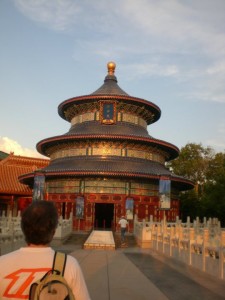
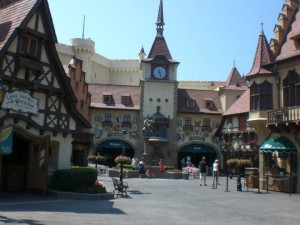
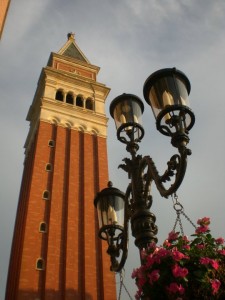




German doesn’t have polka, POLand has POLka. German has oompah music!
Polka originated in Central Europe and each country in the European continent adapted it as their own as its popularity spread. The word polka is actually a Czech word referring to a Polish woman, because it is of Bohemian origin.